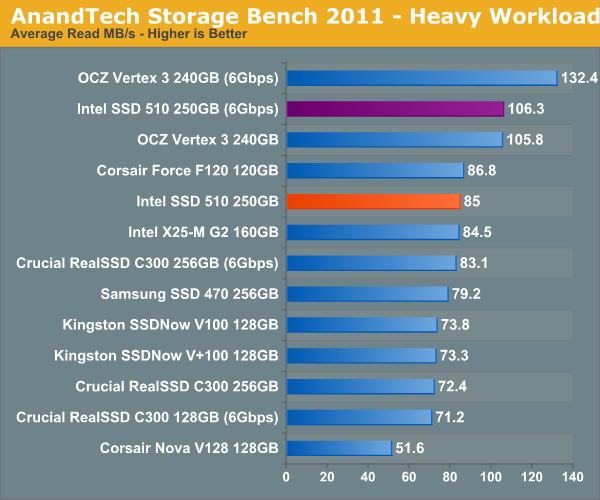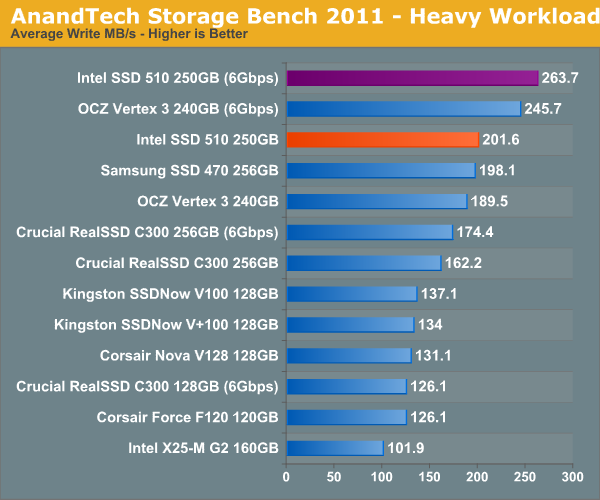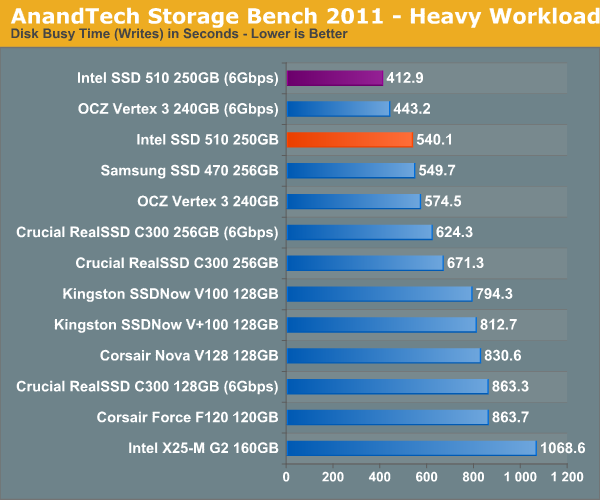The Intel SSD 510 Review
by Anand Lal Shimpi on March 2, 2011 1:23 AM EST- Posted in
- IT Computing
- Storage
- SSDs
- Intel
- Intel SSD 510
AnandTech Storage Bench 2011: Much Heavier
I didn't expect to have to debut this so soon, but I've been working on updated benchmarks for 2011. Last year we introduced our AnandTech Storage Bench, a suite of benchmarks that took traces of real OS/application usage and played them back in a repeatable manner. I assembled the traces myself out of frustration with the majority of what we have today in terms of SSD benchmarks.
Although the AnandTech Storage Bench tests did a good job of characterizing SSD performance, they weren't stressful enough. All of the tests performed less than 10GB of reads/writes and typically involved only 4GB of writes specifically. That's not even enough exceed the spare area on most SSDs. Most canned SSD benchmarks don't even come close to writing a single gigabyte of data, but that doesn't mean that simply writing 4GB is acceptable.
Originally I kept the benchmarks short enough that they wouldn't be a burden to run (~30 minutes) but long enough that they were representative of what a power user might do with their system.
Not too long ago I tweeted that I had created what I referred to as the Mother of All SSD Benchmarks (MOASB). Rather than only writing 4GB of data to the drive, this benchmark writes 106.32GB. It's the load you'd put on a drive after nearly two weeks of constant usage. And it takes a *long* time to run.
I'll be sharing the full details of the benchmark in some upcoming SSD articles but here are some details:
1) The MOASB, officially called AnandTech Storage Bench 2011 - Heavy Workload, mainly focuses on the times when your I/O activity is the highest. There is a lot of downloading and application installing that happens during the course of this test. My thinking was that it's during application installs, file copies, downloading and multitasking with all of this that you can really notice performance differences between drives.
2) I tried to cover as many bases as possible with the software I incorporated into this test. There's a lot of photo editing in Photoshop, HTML editing in Dreamweaver, web browsing, game playing/level loading (Starcraft II & WoW are both a part of the test) as well as general use stuff (application installing, virus scanning). I included a large amount of email downloading, document creation and editing as well. To top it all off I even use Visual Studio 2008 to build Chromium during the test.
Many of you have asked for a better way to really characterize performance. Simply looking at IOPS doesn't really say much. As a result I'm going to be presenting Storage Bench 2011 data in a slightly different way. We'll have performance represented as Average MB/s, with higher numbers being better. At the same time I'll be reporting how long the SSD was busy while running this test. These disk busy graphs will show you exactly how much time was shaved off by using a faster drive vs. a slower one during the course of this test. Finally, I will also break out performance into reads, writes and combined. The reason I do this is to help balance out the fact that this test is unusually write intensive, which can often hide the benefits of a drive with good read performance.
There's also a new light workload for 2011. This is a far more reasonable, typical every day use case benchmark. Lots of web browsing, photo editing (but with a greater focus on photo consumption), video playback as well as some application installs and gaming. This test isn't nearly as write intensive as the MOASB but it's still multiple times more write intensive than what we were running last year.
As always I don't believe that these two benchmarks alone are enough to characterize the performance of a drive, but hopefully along with the rest of our tests they will help provide a better idea.
The testbed for Storage Bench 2011 has changed as well. We're now using a Sandy Bridge platform with full 6Gbps support for these tests. All of the older tests are still run on our X58 platform.
AnandTech Storage Bench 2011 - Heavy Workload
We'll start out by looking at average data rate throughout our new heavy workload test:

There's simply no dethroning the Vertex 3, but Intel's SSD 510 does come dangerously close. Over a 6Gbps interface the 510 delivers 93% of the performance of the Vertex 3. Over a 3Gbps interface the gap narrows to a meager 5.2%.
The breakdown of reads vs. writes tells us more of what's going on:

The Vertex 3 is nearly 25% faster than the 510 if we just isolate the reads conducted by our benchmark. Remember the poor random read performance? I suspect that's at play here. The Intel SSD 510 on a 6Gbps interface is about the speed of the Vertex 3 on a 3Gbps port.

Ah ha! This is where the picture shifts. Our heavy workload does have a significant amount of incompressible writes which significantly reduce the performance of the Vertex 3. The V3 loses enough ground that the 510 is 7% faster in writes during our benchmark.
The next three charts just represent the same data, but in a different manner. Instead of looking at average data rate, we're looking at how long the disk was busy for during this entire test. Note that disk busy time excludes any and all idles, this is just how long the SSD was busy doing something:













128 Comments
View All Comments
Anand Lal Shimpi - Wednesday, March 2, 2011 - link
Correct me if I'm wrong, but I believe everything regarding the 25nm issue has been resolved? OCZ has initiated an exchange program and is covering all associated costs for users that were affected.I'm still curious to look into the behavior of 25nm NAND however by the time I got back from MWC it looks like the bulk of what needed to happen regarding the 25nm issue already happened.
Is there a remaining aspect of the issue that hasn't been addressed that you'd like me to pursue?
Take care,
Anand
semo - Wednesday, March 2, 2011 - link
Hi Anand,Thanks for replying. Just to be clear, what I've been expecting is for you to write a news item or an article about OCZ and 25nm SSDs. It seems you thought I was asking for you fix the problem (it is not your problem and it isn't you who was supposed to fix it).
I still don't understand why all the review sites were silent even after the OCZ 25nm drives hit retail. Was I the only one excited about the new NAND flash tech, and itching to read an in depth review/analysis. Some time passed and some people started complaining that their 25nm V2s were somewhat slower than what reviews (and the packaging) were promising…still no in depth look at 25nm tech at that point.
The jmicron issue was resolved eventually as well but there were a lot of articles written about it.
I’m still stumped as to how hard it is to find a proper review about the 1st ever consumer 25nm SSD to hit retail (the OCZ V2).
m.amitava - Wednesday, March 2, 2011 - link
I am sure Anand has quite a lot of pull with OCZ and I believe users who have been stranded with 25nm drives will thank him for investing his time in sorting out the issue rather than writing on it....would like to hear your POV though Anand, so far you haven't given us your take on it....
FunBunny2 - Thursday, March 3, 2011 - link
-- Is there a remaining aspect of the issue that hasn't been addressed that you'd like me to pursue?Absolutely!!! Not so much the OCZ nonsense, but rather the impact we can expect on SSD acceptance and viability with 25nm parts. IIRC, IMFT NAND at 25nm has/will have ECC on die to deal with some of the issue.
What's not clear is whether an SSD can be built at 25nm that ends up being as "good" as one at 32/34nm at the same price point. We may have hit a corner case in Moore's Law: the reduction in price at 25nm may not be sufficient to overcome both the erasure and electrical issues which present at 25nm. The OCZ fix was to replace larger die with smaller die to get back channels. That's gotta hurt the profit equation. And this doesn't fix the erasure issue.
In other words, there's a whole lot to be delved into with regard to 25nm impact on SSD. A whole lot.
semo - Friday, March 4, 2011 - link
"Correct me if I'm wrong, but I believe everything regarding the 25nm issue has been resolved?"I've just done a quick search on newegg for a Vertex 2 and I still can't figure out at a glance which are the nerfed 25nm drives and which aren't. So the bait-and-switch games is still on as far as I can tell.
Anand Lal Shimpi - Wednesday, March 2, 2011 - link
It really boils down to the performance vs. reliability debate. The Vertex 3 is overall a faster drive (assuming you're not doing much in the way of incompressible writes), however it's unclear how much OCZ and SF have improved their reliability testing and validation. If the 510 is close enough in performance and can boast the same sort of reliability that the original X25-M did, then it may be a viable alternative for some users who aren't as interested in absolute performance but want a product that has gone through Intel's validation/testing.With the X25-M the performance gap was too great to really value the drive over the SF-1200 based offerings. The 510 is much more competitive, although our recommendation for pure performance is still obviously the Vertex 3.
As I mentioned in the conclusion, if OCZ can ramp and ship the Vertex 3 with a better reliability track record than the Vertex 2 (not that the latter was bad, it just wasn't quite as good as the X25-M) then this becomes a non-issue. The way I see it is this: the 510 pressures OCZ to work on validation and QA testing, while the Vertex 3 forces Intel to take performance much more seriously. Both are very important to have in the market.
Take care,
Anand
lyeoh - Wednesday, March 2, 2011 - link
Hi Anand, have you noticed any issues with hibernate for SSDs? Being able to hibernate is rather important for many mobile users.There are some people complaining that hibernate stopped working when they switched to their SSD drive, whereas others say they don't have probs.
As for reliability, how much more reliable are Intel really anyway? They did have problems with their previous drives too.
epicsnackus - Wednesday, March 2, 2011 - link
I have hibernated my laptop with Intel G2 160GB drive every day for more than a year, with no issuejimhsu - Wednesday, March 2, 2011 - link
I do have an issue with sleep though on an Intel SSD. On resume after sleep, the drive errors with KERNEL_NONPAGED bluescreens. Does not occur with hibernate. Any idea what is going on?aarste - Wednesday, March 2, 2011 - link
Not tried Hibernate, but sleep is working fine on my Intel X-25M 80GB (I put the PC to sleep every night), so the BSOD may be something else entirely.